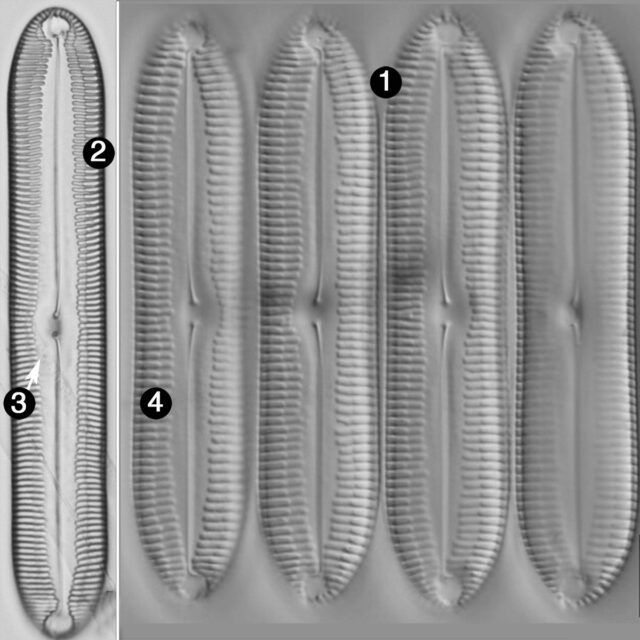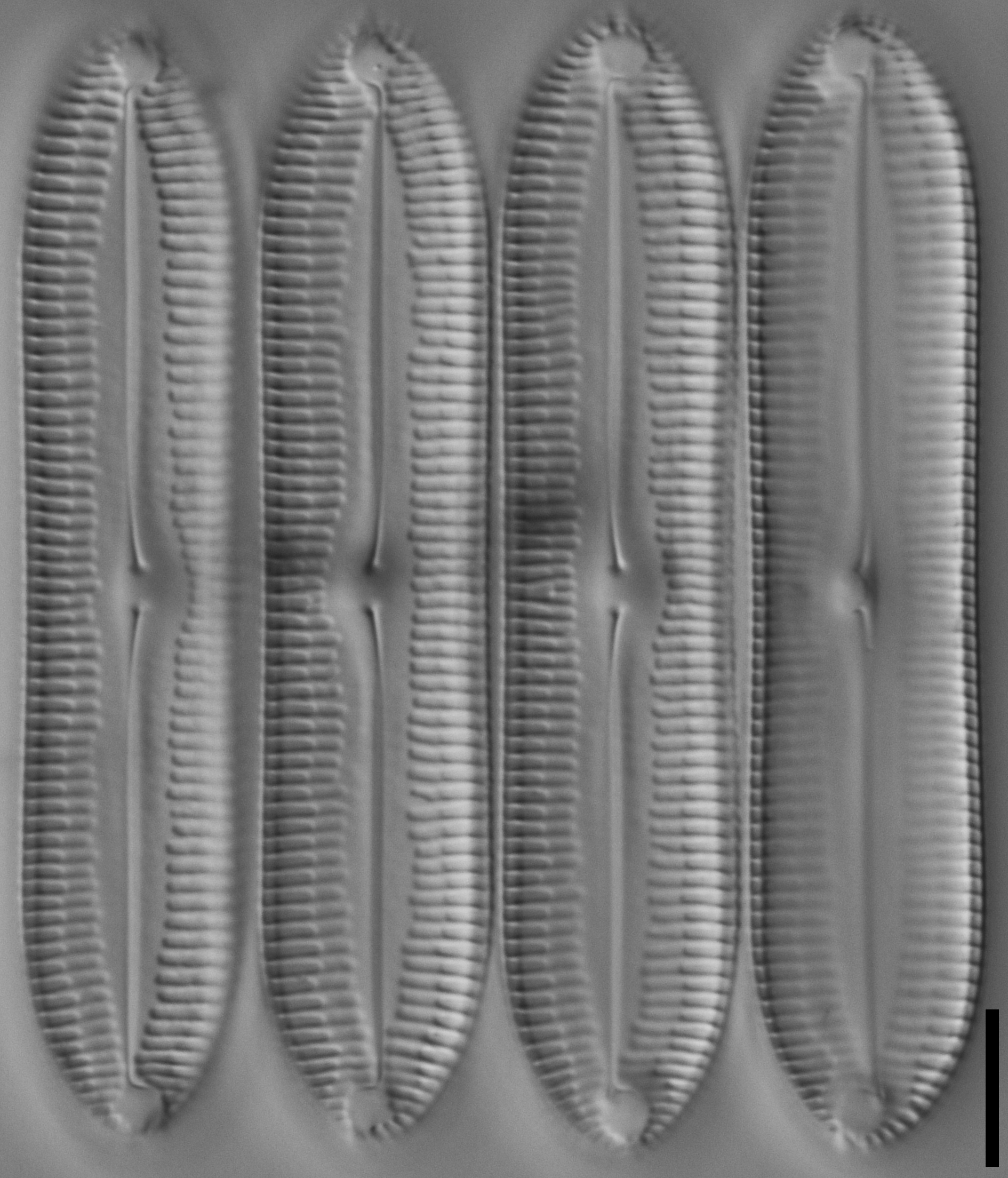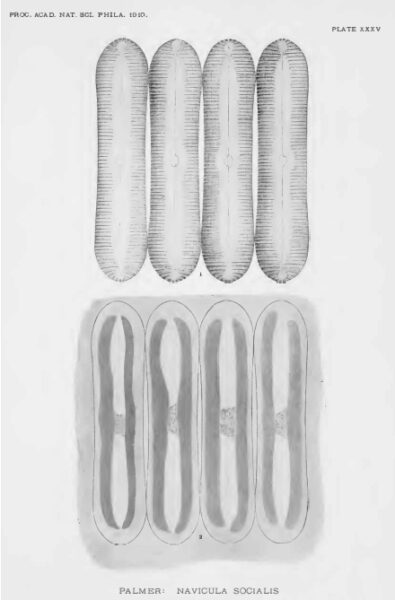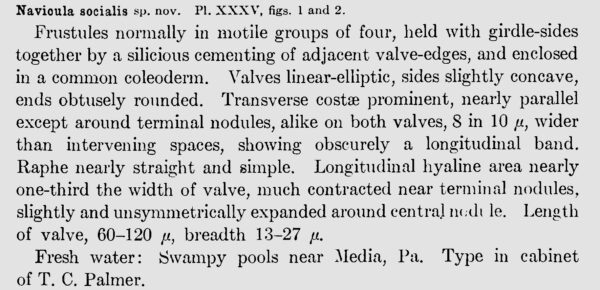Pinnularia socialis
-
Category
-
Length Range71-126 µm
-
Width Range13.7-18.7 µm
-
Striae in 10 µm8-9
-
ContributorMarina Potapova - Jul 2022
-
ReviewerSarah Spaulding - Aug 2022
Identification
View image metadata
Type
Description
Cells are joined by their girdle sides in small colonies of 2 to 4. Valves are broadly linear, with straight or very slightly concave margins and tapering rounded ends. The axial area is 1/3 to 1/2 of the valve width. Central area is barely noticeable as a slight widening of the axial area or may be almost indistinguishable from the axial area. Striae are parallel or very weakly radiate. The raphe is lateral, with expanded proximal ends deflected toward the primary valve side. The terminal fissures are sickle-shaped.
Palmer (1910) in his original description of Navicula socialis gives the valve width of 13 to 27 µm. This appears to be a typographic error, as no valves wider than 19 µm are found on slides made from the material from the type locality.
Autecology
This interesting colonial Pinnularia is documented here from the type material in Media, Pennsylvania and from samples from Connecticut. This is one of a few Pinnularia species that form colonies of predominantly four cells joined by the mucilage at their girdles similarly to P. cardinaliculus (Round 1988).
-
Size Range, µm3
-
Motility
-
Attachment
-
Colony
-
Occurrence
-
BCG
-
Waterbody
- Learn more about this
Original Description
Navicula socialis sp. nov. Pl. XXXV, figs. 1 and 2.
Frustules normally in motile groups of four, held with girdle-sides together by a silicious cementing of adjacent valve-edges, and enclosed in a common coleoderm. Valves linear-elliptic, sides slightly concave, ends obtusely rounded. Transverse costae prominent, nearly parallel except around terminal nodules, alike on both valves, 8 in 10 µ, wider than intervening spaces, showing obscurely a longitudinal band. Raphe nearly straight and simple. Longitudinal hyaline area nearly one-third of the width of valve, much contracted near terminal nodules, slightly and unsymmetrically expanded around central nodule. Length of valve, 60-120 µ, breadth 13-27 µ.
Fresh water: Swampy pools near Media, Pa. Type in cabinet of T. C. Palmer.
-
BasionymNavicula socialis
-
AuthorT.C.Palmer 1910
-
Length Range60-120 µm
-
Width13-27 µm
Citations & Links
Citations
Cite This Page
Potapova, M. (2022). Pinnularia socialis. In Diatoms of North America. Retrieved November 21, 2024, from https://diatoms.org/species/pinnularia-socialis
Responses
The 15 response plots show an environmental variable (x axis) against the relative abundance (y axis) of Pinnularia socialis from all the stream reaches where it was present. Note that the relative abundance scale is the same on each plot. Explanation of each environmental variable and units are as follows:
ELEVATION = stream reach elevation (meters)
STRAHLER = distribution plot of the Strahler Stream Order
SLOPE = stream reach gradient (degrees)
W1_HALL = an index that is a measure of streamside (riparian) human activity that ranges from 0 - 10, with a value of 0 indicating of minimal disturbance to a value of 10 indicating severe disturbance.
PHSTVL = pH measured in a sealed syringe sample (pH units)
log_COND = log concentration of specific conductivity (µS/cm)
log_PTL = log concentration of total phosphorus (µg/L)
log_NO3 = log concentration of nitrate (µeq/L)
log_DOC = log concentration of dissolved organic carbon (mg/L)
log_SIO2 = log concentration of silicon (mg/L)
log_NA = log concentration of sodium (µeq/L)
log_HCO3 = log concentration of the bicarbonate ion (µeq/L)
EMBED = percent of the stream substrate that is embedded by sand and fine sediment
log_TURBIDITY = log of turbidity, a measure of cloudiness of water, in nephelometric turbidity units (NTU).
DISTOT = an index of total human disturbance in the watershed that ranges from 1 - 100, with a value of 0 indicating of minimal disturbance to a value of 100 indicating severe disturbance.

Pinnularia socialis
- Cells joined at valve margin into colonies
- Valves broadly linear
- Axial area broad
- Striae are parallel or very weakly radiate
Cells are joined by their girdle sides in small colonies of 2 - 4. The axial area is broad, 1/3 to 1/2 of the valve width. Striae are parallel, or very weakly radiate.
 Diatoms of North America
Diatoms of North America







